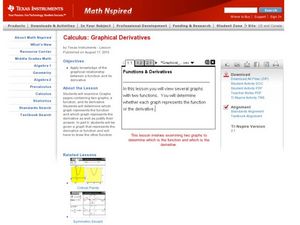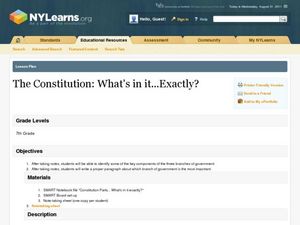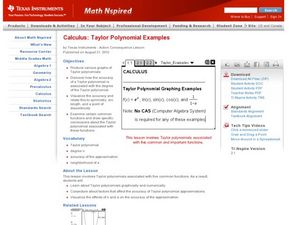Curated OER
Dealing with Data in Elementary School
Students follow the scientific method in collecting data. In this following the scientific method in collecting data instructional activity, students develop a question they would like answered such as how many aluminum cans are consumed...
Curated OER
What Are Erosion and Sediments?
Students create experiments in class based on the erosion of Earth. In this erosion lesson, students perform a lab in class replicating the effects of erosion. Students finally draw their own conclusions based on the research performed.
Curated OER
U.S. Involvement in WWI – The Zimmerman Note
Students investigate the significance of the Zimmerman Note. In this World War I lesson, students use the provided analysis sheet to analyze the contents of the Zimmerman note and discuss how the note led to U.S. involvement in World War I.
Curated OER
Earth Day for a Small World
Students explore what it means to be a good steward of the environment. In this Earth Day lesson, students create watercolor pictures of how to take care of the earth. They brainstorm ideas for an Earth Day project.
Curated OER
Wreck Detectives
Students investigate shipwrecks. In this marine archaeology lesson ,students collect data and make inferences about the causes of shipwrecks. Students work in groups to create their own model of a shipwreck using clay. Students then...
Texas Instruments
Graphical Derivatives
Pupils solve functions using the derivative. They determine the derivative of a function based on its graph, then analyze different functions and draw a relationship and conclusion based on the graph.
Curated OER
Brine Shrimp Hatching Experiment
Learners hatch brine shrimp in a classroom experiment. In this hatching brine shrimp lesson, students participate in two-week lab in which they study how brine shrimp hatch under different conditions. They record data about the control...
Curated OER
Reflections
In this reflections learning exercise, 10th graders solve and complete 34 different problems that include determining various reflections. First, they trace the figure and draw its reflection in each line. Then, 10th graders use the...
Curated OER
Change in Early 20th Century America: Doing the Decades
Young scholars investigate and develop relationships between selected themes and resources. In this Us history lesson plan, students interpret, analyze, and evaluate shifts in continuity throughout US history. Young scholars will create ...
Curated OER
Biology: Understanding Cellular Organelles
Learners distinguish the differences between Prokaryotic and Eukaryotic cells. Using microscopes, they examine a variety of plant and animal cells. Working in groups, they draw and label plant and animal cells and show the mathematical...
Curated OER
Comparing Family Photos
Fourth graders bring in a family photo from home. They compare their photo to the Rawding family photo. Students share their conclusions orally. They use Venn Diagrams to organize their thoughts and observations.
Curated OER
Levels of Classification
Students use diagrams to compare structural differences that taxonomists use to classify animals. For this classification lesson plan, students compare structures of different species from given diagrams. In one diagram they identify the...
Curated OER
Force & Acceleration
Students investigate the effects of weights on the motion of a toy car. In this force and acceleration lesson plan, students use different weights, a toy car, a paper clip and string to determine how a car will move as different weights...
Curated OER
George Washington: First in War, First in Peace, and First in the Hearts of His Countrymen
Learners interpret historical evidence presented in primary and secondary resources. In this George Washington lesson plan, students research the details of Washington's military successes, his role at the Constitutional Convention, and...
Curated OER
Mira, Mira on the Wall: Reflections
Learners investigate and perform reflections and symmetry. In this geometry lesson, students compare and contrast the relationship between reflections and symmetries.
Curated OER
Catapults
Students test catapults. In this physics lesson, student conduct scientific investigations that require them to test catapults. Students practice their problem solving skills as they employ the use of the scientific method.
Curated OER
Powerful Patterns
Students use logical thinking to create, identify, extend and translate patterns. For this pattern lesson, students make patterns with objects, numbers, and shapes. Students extend and translate these patterns in several modalities...
Curated OER
The Constitution: What's in It...Exactly?
Seventh graders examine the U.S. Constitution. In this American government lesson plan, 7th graders listen to a SMART Board-supported lecture about the branches of the U.S. government. Students write responses based on the lecture.
Curated OER
Taylor Polynomial Examples
Learners graph Taylor polynomials. For this calculus lesson, students relate accuracy of a Taylor polynomial to the degree of the equation. They graph their polynomials using the TI calculator.
Curated OER
The Solar Cycle
Students research the solar cycle. In this Science lesson, students use the internet to investigate the solar cycle. Students produce a spreadsheet and graph from the information collected.
Curated OER
Column Chromatography
Students research the mechanics of liquid chromatography. In this technology lesson, students calculate the concentration of unknown samples. They write a report about their research and lab results.
Curated OER
Molly's Pilgrim and Thanksgiving Activities
The tender story of Molly's Pilgrim, coupled with a history mini-lesson, is a great way to discuss the meaning of Thanksgiving.
Curated OER
Fairy Tales
Sixth graders explore the elements of fairy tales. In this fairy tales lesson, 6th graders analyze several versions of Cinderella from around the world. Students graph fairy tale elements using Excel and create Venn diagrams comparing...
Curated OER
Calculating Profits from Selling Virtual Lemonade
Students set up and collect data for a virtual lemonade stand. In this entrepreneurship, economics, and technology lesson, students purchase ingredients, determine costs, and set up a virtual lemonade stand. Students consider weather...

























